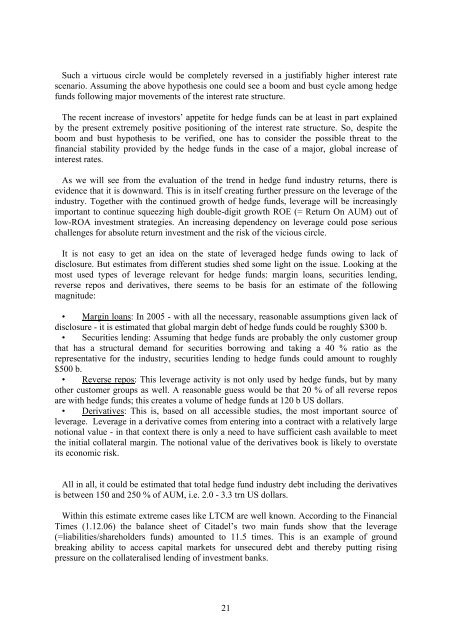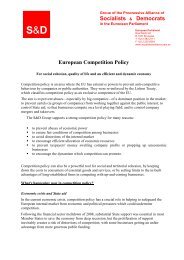Executive summary - Udo Bullmann
Executive summary - Udo Bullmann
Executive summary - Udo Bullmann
- No tags were found...
You also want an ePaper? Increase the reach of your titles
YUMPU automatically turns print PDFs into web optimized ePapers that Google loves.
Such a virtuous circle would be completely reversed in a justifiably higher interest ratescenario. Assuming the above hypothesis one could see a boom and bust cycle among hedgefunds following major movements of the interest rate structure.The recent increase of investors’ appetite for hedge funds can be at least in part explainedby the present extremely positive positioning of the interest rate structure. So, despite theboom and bust hypothesis to be verified, one has to consider the possible threat to thefinancial stability provided by the hedge funds in the case of a major, global increase ofinterest rates.As we will see from the evaluation of the trend in hedge fund industry returns, there isevidence that it is downward. This is in itself creating further pressure on the leverage of theindustry. Together with the continued growth of hedge funds, leverage will be increasinglyimportant to continue squeezing high double-digit growth ROE (= Return On AUM) out oflow-ROA investment strategies. An increasing dependency on leverage could pose seriouschallenges for absolute return investment and the risk of the vicious circle.It is not easy to get an idea on the state of leveraged hedge funds owing to lack ofdisclosure. But estimates from different studies shed some light on the issue. Looking at themost used types of leverage relevant for hedge funds: margin loans, securities lending,reverse repos and derivatives, there seems to be basis for an estimate of the followingmagnitude:• Margin loans: In 2005 - with all the necessary, reasonable assumptions given lack ofdisclosure - it is estimated that global margin debt of hedge funds could be roughly $300 b.• Securities lending: Assuming that hedge funds are probably the only customer groupthat has a structural demand for securities borrowing and taking a 40 % ratio as therepresentative for the industry, securities lending to hedge funds could amount to roughly$500 b.• Reverse repos: This leverage activity is not only used by hedge funds, but by manyother customer groups as well. A reasonable guess would be that 20 % of all reverse reposare with hedge funds; this creates a volume of hedge funds at 120 b US dollars.• Derivatives: This is, based on all accessible studies, the most important source ofleverage. Leverage in a derivative comes from entering into a contract with a relatively largenotional value - in that context there is only a need to have sufficient cash available to meetthe initial collateral margin. The notional value of the derivatives book is likely to overstateits economic risk.All in all, it could be estimated that total hedge fund industry debt including the derivativesis between 150 and 250 % of AUM, i.e. 2.0 - 3.3 trn US dollars.Within this estimate extreme cases like LTCM are well known. According to the FinancialTimes (1.12.06) the balance sheet of Citadel’s two main funds show that the leverage(=liabilities/shareholders funds) amounted to 11.5 times. This is an example of groundbreaking ability to access capital markets for unsecured debt and thereby putting risingpressure on the collateralised lending of investment banks.21





